
HOME / Departments / Physics / Physics of Complex System
Physics of Complex System / Biological Soft Matter
-
- KIMURA Yasuyuki, Professor
- KOBAYASHI Fumiaki, Assistant Professor
- We are the experimental research group that investigates Non-equilibrium Physics of “soft materials” (e.g. colloids, polymers and liquid crystals). Much of the diversity in nature depends on the complex hierarchical ordering of these soft materials and their slow cooperative dynamics, that are the focus of our study. Dynamic self-assembly of soft materials, for instance, creates exquisite structures in living organisms that are under constant activation by their own metabolism. We investigate such nonequilibrium processes that obviously do not obey the statistics of thermodynamic equilibrium, by developing novel state-of-the-art experimental and theoretical techniques.
Soft matter (Kimura, Inagaki)
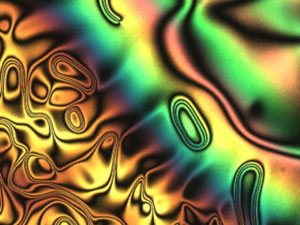
The main themes of our research is “soft matter”, such as macromolecules, proteins, lipid molecules, liquid crystal, and colloids. They are not only ubiquitous in our daily life but also important constituents of living organisms. We aim to elucidate material properties of soft matter from a physical point of view. The knowledge will be applicable to build novel microscale devices. We also develop original methods for measuring microscale material properties with specialized microscopic imaging technique and optical tweezers.
Liquid crystals and colloids:
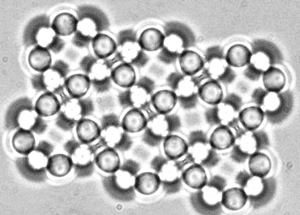
We develop a method to fabricate complex colloidal assemblies in a cell filled with nematic liquid crystal as shown in Fig. 2. It is possible to fabricate various configuration, such as triangle, square, pentagon, and hexagon. The configuration in Fig. 2 consists of octagons and squares, which is known to be Archimedes’ tiling. We apply AC electric field to these configurations and investigate the responses. This fabrication method is promising technique to produce open photonic crystals, which is useful to make efficient optical fibers.
Electrohydrodynamics of liquid crystals:
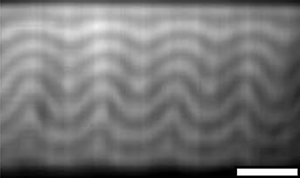
We investigate three-dimentional structure of nematic and laminar liquid crystals with Fluorescence Confocal Polarizing Microscopy(FCPM). Depending on the voltage of the electric field, liquid crystal change their structures. When we use Cholestric liquid crystal, in which liquid crystal molecules have chirality, they form several layers. As the voltage is increased, the layers start to bend and buckle (Fig.3). At a critical voltage, they form layer structures again, but the number of layers increases by one.
Collective behaviors in patchy colloidal particles:
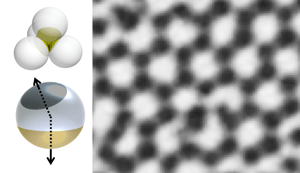
The exotic collective behaviors of anisotropic colloidal particles currently attract huge attentions of researchers. We study patchy particles, which possess anisotropy in surface chemistry and thus in short-range interaction with/without shape anisotropy, experimentally and numerically. We have found their unique self-assembly and ordering, where the anisotropy plays an essential role. Figure 4 shows self-organized structure of patchy particles. The silica particles are partially coated with gold.
Granular materials:
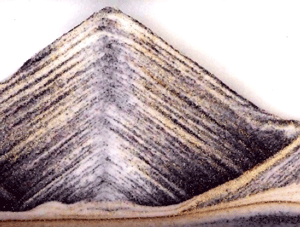
We are also interested in granular media as one of non-equilibrium dissipative systems. Granular materials are assemblies of particles typically larger than 0.1mm in diameter. The particles are sufficiently large and not affected by thermal fluctuations. Particles lose their kinetic energy by inelastic collisions and frictional interaction at the surface. Due to the strong dissipative interaction between constituents, they often show intriguing behavior. One of the examples is shown in Fig. 5. When mixtures of various sizes of grains are poured on the bottom, grains are spontaneously segregated by their size and a pile is formed with layers.
Biophysics, Active matter (Mizuno)
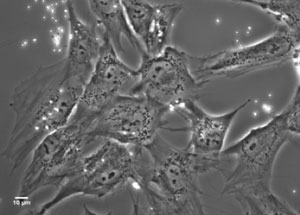
Seen as a material, the interior of biological cells is a very unique kind of active system, driven away from equilibrium by the internal energy-dissipating and force-generating machinery. Core of active cell interior, such as Active cytoskeletons and glassy cytoplasm, are physically driven by mechano-enzymes (motor proteins). We have shown, for instance, that fundamental theorems in statistical physics (Fluctuation-Dissipation theorem and Central Limiting theorem) are both violated in theses systems. Using the state-of-the-art technologies and theories, we investigate the out-of-equilibrium machinery in various living and active soft materials.
Violation of fluctuation–dissipation theorem:
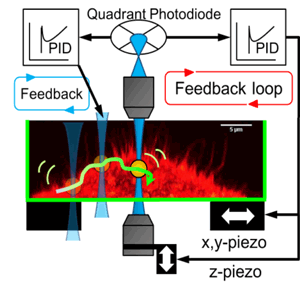
is a metrics of “activity” that can be quantified by observing the fluctuations and response of a probe particle, simultaneously. We developed a technology that allows to perform this in active materials with vigorous fluctuations (Fig. 7); a probe in living cells were stably tracked with dual smooth 3-dimensional feedback. We found the violation of the theorem due to non-thermal fluctuations, especially in the low-frequency domain where the out-of-equilibrium activity should critically affect the mechanics of active cellular constituents.
Violation of central limiting theorem:
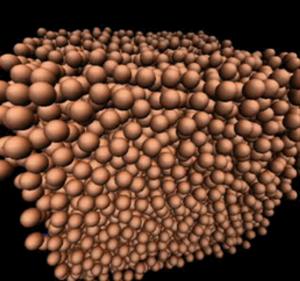
Nature is full of power-law interactions, e.g., gravity, electrostatics, and hydrodynamics. When sources of such interactions are distributed in space, the superposed interaction, which is what we observe, is naively expected to follow a Gauss or Lévy distribution. We have shown that the actual distribution frequently converges to something in between these limit distributions. We derived an analytical expression that bridges, continuously, the gap between them, depending on physical parameters. By comparing with non-Gaussian fluctuations observed in Active cytoskeletons, bacterial bath and colloidal glass (Fig. 8), the general origin of non-Gauss and non-Lévy dist
Work extraction machinery in single motor proteins far from equilibrium:
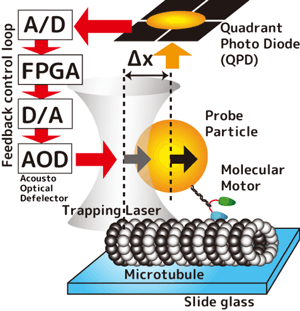
A large variety of molecular machines are working in cells. “Molecular motors” carry cargos, just as hall porters do. By using an optical trap apparatus elaborated with feedback mechanism (Fig. 9), a single molecular motor is directly manipulated and observed with nanometer accuracy. Based on the novel theories in non-equilibrium statistical physics (Harada-Sasa and fluctuation theorems), we try to unzip the question: how does each individual molecule convert chemical energy into the mechanical work? We further investigate the machinery of molecular motors in crowded environment relevant for living cells.